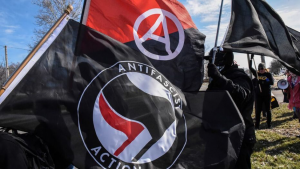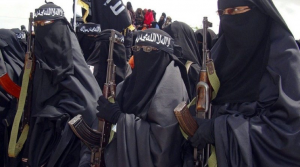
Image Source: Fox News, Lukas Mikelionis
- Based on Marxist principles – left wing extremists believe that the working class should revolt against those in power; Can often be classified as “antifascist”.
- One of the major goals of left-wing terrorism is the creation of a “utopian” society
- There is absolutely no religious facet of leftist ideology
- One of their biggest tactics is “provocation” – provoking those in power to overreact in order to garner more sympathy and members
- Primary targets are government buildings, symbols of authority, and right-wing conservative rallies/demonstrations
Summary of Extremist Narrative
The leftist narrative can be defined as a desire to overthrow the current political state and replace it with an anarchist or communist system. Members of these left-wing groups are often-times autonomists, which is a term used to describe individuals who are anti-authoritarian and believe they exist outside of the political system. One of the biggest characteristics of these groups is the desire for society as a whole to rise up and revolt. These left-wing groups do not discriminate and allow anyone who believes in their ideology to join their ranks.
History of Ideology in the United States
Leftist ideology originated around the time of the industrial revolution. Many were flocking from the countryside to find jobs in new factories, making the demand for work very high. Factory owners had no trouble filling vacant spots. Karl Marx, a German law student, saw the differences between the workers and the factory owners and started to describe the working class as “proletariat” and the factory owners as “bourgeoisie”. He saw that the factory owners did not have to work as hard as the working class, yet they kept getting richer and richer. Marx called this a “capitalist society” and believed that a revolution of the working class was inevitable. He believed that the working class would be victorious and a “communist society”. This formed the basis of leftist extremism, with individuals believing that a classless, moneyless, and stateless society is the only option.
During the 1980’s, left-wing terrorism was attributed to 74% of all terrorist attacks in the US Left wing terrorist groups today are based in communism, anarchism, or socialism, which are all connected to Marx’s teachings. Today, these groups are reflections of the current political climate meaning that members of these groups believe that the political culture of their country is too right-wing or fascist. Throughout history, there have been several known leftist groups that operated within the US, including the United Freedom Front, New World Liberation Front, Weather Underground, Black Liberation Army, and ANTIFA. Some of these groups are supported from outside countries such as Cuba, China, and Russia. They have also found support in the Communist Party of the USA. Just recently, Trump declared that he may soon try to classify ANTIFA as a major terrorist organization.
Current State of Far-Left Extremism
Left-wing extremists are still active, not only in the U.S., but around the world. While these leftist groups serve different purposes, they all have an underlying theme of replacing the existing political system and removing class labels. Some even aim to carve out new nations within the US. Although the FBI reports that right-wing extremists are more of a concern today than left-wing extremists, they also acknowledge that left wing extremism still exists and should not be ignored.
As David Rapoport has stated, terrorism comes in waves. Left-wing terrorism was highly active in the 19060’s to the mid-1980’s, after which right-wing terrorism became active. This suggests that left-wing terrorism will become more active in the coming years. Due to the fact that left-wing extremists are more likely to be educated and from urban areas, they are better able to effectively organize demonstrations and attacks than their right-wing counterparts.
One of the more active left-wing groups in the US today is ANTIFA. ANTIFA’s main ideology is rooted in the antifascist movement, which was first seen under Hitler’s rule in Nazi Germany. Today, the antifascist movement is violent and threatening to society at large. ANTIFA members attend alt-right movements and demonstrations in order to protest and put an end to “alt right messages of hate.” ANTIFA leaders have called for violence in order to confront conservative groups, often times putting innocent people in danger. Some of their tactics include burning cars, attacking right-wing protestors, and destroying property/businesses.
ANTIFA does not have a clear, hierarchical structure, bringing us back to one of the main characteristics of left-wing groups; anyone can join and participate as long as they support the cause. There are times when ANTIFA members will call for non-members to meet them at rallies in order to protest against right-wing conservatives.
Left-wing extremist groups are primarily operating under capitalist systems where they believe that there are inexpressive amounts of marginalization and inequality at the hands of the current political party. These groups often attend right-wing conservative rallies in order to violently protest and oppose right-wing hate rhetoric.
As mentioned earlier, left-wing groups do not discriminate against members and believe that anyone who believes in their antifascist cause can join their movement. There are no religious undertones, making this group very diverse and fluid in their recruitment. Left-wing groups also utilize social media in order to attract individuals to their movement. They will often call on others to join their cause, recruiting individuals who may feel marginalized or disgruntled with their current political climate.
The Extremism Assessment Series is an initiative of Rise to Peace’s Domestic Counter Terrorism Program. It seeks to provide short educational pieces highlighting groups or social movements linked to extremist ideologies and/or tactics. Check back for new additions to the series.









